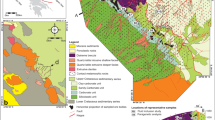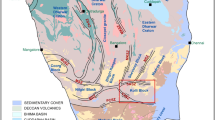Summary
In the West Rand Group of the 3.07–2.71 Ga old Witwatersrand Supergroup, South Africa, a series of banded iron-formations occur. They are of chemical origin and were deposited in an offshore shelf environment. The coarser-grained, in places pyrite-bearing, and partly auriferous metasedimentary rocks forming the bulk of the Witwatersrand Supergroup are regressive. The iron-formations, however, were deposited during transgression. The presence of allogenic pyrite in the fluviatile metaconglomerates and that of magnetite and, in places, haematite in the marine iron-formations suggests a lower pH and higher sulfur activity for the Archaean meteoric environment than for recent hydrothermal fluids on the ocean floor. Post-depositional alteration of the Witwatersrand rocks includes burial metamorphism at temperatures between 300 and 350 °C and pressures around 2.5 kbar, and multiple hydrothermal inflitration events at slightly lower temperatures, coeval with the brittle deformation of the basin fill during the deposition of the Transvaal Supergroup and the Bushveld Vredefort events.
Additional thermal metamorphic overprint of the iron-formations around the Vredefort Dome caused the growth of orthoamphiboles. They show a wide range of compositions between ferro-anthophyllite and ferrous alumino-gedrite, suggesting that the crest of the solvus curve for Fe-rich orthoamphiboles is below 500 °C.
Chlorite and amphibole compositions, and the presence of Fe-oxide-bearing horizons between pyrite-bearing ones indicate that the fluid composition during post-depositional alteration was largely controlled by the bulk rock composition of the infiltrated stratigraphic horizons and not by some external source.
Zusammenfassung
Die West Rand Group innerhalb der 3.07–2.71 Milliarden Jahre alten Witwatersrand Supergroup, Südafrika, führt eine Reihe von Magnetit- und Hämatit-haltigen Eisenformationen. Diese sind chemischen Ursprungs und wurden in einem flachmarinen Schelfmilieu abgelagert. Der überwiegende Teil der Witwatersrand Abfolge, bestehend aus klastischen, verschiedentlich Pyrit-führenden und teilweise goldhaltigen Metasedimentgesteinen, kann regressiven Phasen zugeschrieben werden. Die Eisenformationen wurden hingegen während transgressiven Phasen abgelagert. Aufgrund des Auftretens allogener Pyrite in den fluviatilen Konglomeratlagen und von Magnetit und Hämatit in den marinen Eisenformationen lassen sich für den meteorischen Bereich im Archaikum niedrigere pH-Werte und höhere Schwefelfugazität ableiten als für rezente submarine hydrothermale Fluide. Post-diagenetische Alterationsprozesse sind der Versenkungsmetamorphose mit Temperaturen zwischen 300 und 350 °C und Drucken um 2.5 kbar sowie etwas niedriger temperierten hydrothermalen Fluiden zuzuschreiben, die als Folge der inkompetenten Deformation der Beckenfüllung in diese während mehrer Stadien infiltrierten. Infiltration hydrothermaler Fluide während der Ablagerung der Transvaal Supergroup (2.55 Ga) und während des Bildung der Vredefort Struktur (2.0 Ga) sind durch Altersdaten belegt.
Zusätzliche thermische Metamorphose der Fe-reichen Pelite und Eisenformationen im Bereich der Vredefort Struktur führte zur Bildung von Orthoamphibolen, deren Zusammensetzung von Anthophyllit bis zu Fe-reichem Alumino-Gedrit reicht. Dies läßt darauf schließen, daß die Solvuskurve für Fe-reiche Orthoamphibole unterhalb von 500 °C liegt.
Die Zusammensetzung der Chlorite und Amphibole sowie das Auftreten von Fe-Oxid-führenden Horizonten in den generall Pyrit-reichen Metasedimentgesteinen gestatten die Annahme, daß die post-diagenetische Fluidzusammensetzung hauptsächlich durch die jeweilige Zusammensetzung der infiltrierten Gesteinshorizonte und nicht durch eine externe Quelle bestimmt wurde.
Similar content being viewed by others
References
Armstrong RA, Compston W, Retief EA, Williams LS, Welke HJ (1991) Zircon ion microprobe studies bearing on the age and evolution of the Witwatersrand basin. Precamb Res 53: 243–266
Armstrong RA, Fanning CM, Eldridge CS, Frimmel HE (1995) Geochronological and isotopic constraints on provenance and post-depositional alteration of the Witwatersrand Supergroup. Centennial Geocongress, Geol Soc S Aft, April 3–7 1995, Johannesburg, vol 2, p 1086 (Abstract)
Berman RG (1988) Internally-consistent thermodynamic data for stoichiometric minerals in the system Na2O-K2O-CaO-MgO-FeO-Fe2O3-Al2O3-SiO2-TiO2-H2O-CO2. J Petrol 29: 445–522
Beukes NJ, Strauss H (1995) Petrography and geochemistry of the Jan Smuts (Contorted Bed) iron-formation of the West Rand Group. Centennial Geocongress, Geol Soc S Afr, April 3–7 1995, Johannesburg, 2, pp 1087–1088 (Abstract)
Bisschoff AA (1982) Thermal metamorphism in the Vredefort Dome. Geol Soc South Africa Trans 85: 43–57
Boer RH, Reimold W U, Kesler SE (1995) Conditions of gold mobilization in the Ventersdorp Contact Reef, Witwatersrand Basin. Centennial Geocongress, Geol Soc S Afr, April 3–7 1995, Johannesburg, vol 2, p 696 (Abstract)
Bryndzia LT, Scott SD (1987) The composition of chlorite as a function of sulfur and oxygen fugacity: an experimental study. Am J Sci 287: 50–76
Cathelineau M (1988) Cation site occupancy in chlorites and illites as a function of temperature. Clay Minerals 23: 471–485
Corner B, Wilshire WA (1989) Structure of the Witwatersrand Basin derived from interpretation of aeromagnetic and gravity data. In:Garland GD (ed) Proc Exploration '87: 3rd Decennial International Conference on Geophysical and Geochemical Exploration for Minerals and Groundwater. Ontario Geol Surv [Spec Vol] 3: 532—546
Ding K, Seyfried WE (1992) Determination of Fe-Cl complexing in the low pressure supercritical region (NaCl fluid): iron solubility constraints on pH of subseafloor hydrothermal fluids. Geochim Cosmochim Acta 56: 3681–3692
Eldrige CS, Phillips GN, Myers RE (1993) Sulfides in the Witwatersrand gold fields: new perspectives on old sediments via SHRIMP. Ann Meet Geol Soc Amer, Abstr 25, A278 (Abstract)
Eriksson PG, Turner BR, Vol RG (1981) Evidence of tidal processes from the lower part of the Witwatersrand Supergroup, South Africa. Sediment Geol 29: 309–325.
Frimmel HE (1994) Metamorphism of Witwatersrand gold. Explor Mining Geol 3: 357–370
Frimmel HE, le Roex AP, Knight J, Minter WEL (1993) A case study on the post-depositional alteration of the Witwatersrand Basal Reef gold placer. Econ Geol 88: 249–265
Frimmel HE, le Roex AP, Knight J, Minter WEL (1994) A case study on the post-depositional alteration of the Witwatersrand Basal Reef gold placer — a reply. Econ Geol 255–257
Gartz VH, Frimmel HE, Gerneke D (1995) The application of cathodoluminescence to Witwatersrand quartz. Centennial Geocongress, Geol Soc S Afr, April 3–7 1995, Johannesburg, vol 2, pp 923–926 (Abstract)
Hallbauer DK (1986) The mineralogy and geochemistry of Witwatersrand pyrite, gold, uranium, and carbonaceous matter. In:Anhaeusser CR, Maske S (eds) Mineral deposits of Southern Africa. Geol Soc S Afr, Johannesburg, pp 731–752
Helgeson HC, Delany JM, Nesbitt HW, Bird DK (1978) Summary and critique of the thermodynamic properties of rock-forming minerals. Am J Sci 278-A: 229 pp
Holland HD (1984) The chemical evolution of the atmosphere and the oceans. Princeton University Press, Princeton 582 pp
Hutchinson RW, Viljoen RP (1988) Re-evaluation of gold sources in Witwatersrand ores. South Afr J Geol 91: 157–173
Leake BE (1978) Nomenclature of amphiboles. Can Mineral 16: 501–520
Liebenberg WR (1955) The occurrence and origin of gold and radioactive minerals in the Witwatersrand System, the Dominion Reef, the Ventersdorp Contact Reef and the Black Reef. Trans Geol Soc S Afr 58: 101–223
Martini JEJ (1992) The metamorphic history of the Vredefort Dome at approximately 2 Ga as revealed by coesite-stishovite-bearing pseudotachylites. J Metamorph Geol 10: 517–527
Meyer FM (1991) Chlorite thermometry in the VCR and the Carbon Leader Reef of the West Wits Line. 7th Annual Conference, Tectonics Division, Geol Soc S Afr, Feb 7, 1991, Johannesburg, pp 21–22 (Abstract)
Meyer FM, Wallmach T, Hencekl J, Schweitzer JK (1990) Chlorite compositions and fluid conditions in some Witwatersrand reefs. Geocongress '90, Geol Soc S Aft, July 2–6 1990, Cape Town, pp 391–394 (Abstract)
Minter WEL, Goedhart M, Knight J, Frimmel HE (1993) The morphology of Witwatersrand gold grains from the Basal Reef: evidence for their detrital origin. Econ Geol 88: 237–248
Miyano T, Klein C (1989) Phase equilibria in the system K2O-FeO-MgO-Al2O3-SiO2-H2O-CO2 and the stability limit of stilpnomelane in metamorphosed Precambrian ironformations. Contrib Mineral Petrol 102: 478–491
Phillips GN, Myers RE (1989) The Witwatersrand Gold fields, part II. An origin for Witwatersrand gold during metamorphism and associated alteration. In:Keys RR Ramsay WRH, Groves DI (eds) The geology of gold deposits: the perspective in 1988. Econ Geol Monogr 6: 598–608
Popp RK, Gilbert MC, Craig JR (1977a) Stability of Fe-Mg amphiboles with respect to oxygen fugacity. Am Mineral 62: 1–12
Popp RK, Gilbert MC, Craig JR (1977b) Stability of Fe-Mg amphiboles with respect to sulfur fugacity. Am Mineral 62: 13–30
Powell R, Holland TJB (1988) An internally consistent thermodynamic dataset with uncertainties and correlations 111. Application methods, worked examples and a computer program. J Metamorph Geo 6: 173–204
Ramdohr P (1958) New observations on the ores of the Witwatersrand in South Africa and their genetic significance. Trans Geol Soc S Afr 61 (Annexure): 50 pp
Reynolds DK (1991) The significance of diamictites in the Witwatersrand Government Subgroup, Klerksdorp gold field, South Africa. Thesis, University of Cape Town, 59 pp (unpublished)
Robb LJ, Meyer FM (1991) A contribution to recent debate concerning epigenetic versus syngenetic mineralization processes in the Witwatersrand basin. Econ Geol 86: 396–401
Robinson P, Ross M, Jaffe HW (1971) Composition of the anthophyllite-gedrite series, comparisons of gedrite and hornblende, and the anthophyllite-gedrite solvus. Am Mineral 56: 1005–1041
Robinson P, Spear FS, Schuhmacher JC, Laird J, Klein C, Evans BW, Doolan BL (1982) Phase relations of metamorphic amphiboles: natural occurrence and theory. In:Veblen DR, Ribbe PH (eds) Amphiboles: petrology and experimental phase relations. Rev Mineral 9B: 1–227
Ross M, Papike JJ, Wier Shaw K (1969) Exsolution textures in amphiboles as indicators of sub-solidus thermal histories. Mineral Soc Amer, Spec Paper 2: 275–299
Schidlowski M (1968) The gold fraction of the Witwatersrand conglomerates from the Orange Free State Goldfield (South Africa). Mineral Deposita 3: 344–363
Schidlowski M, Junge C (1973) Die Evolution der Erdtamosphäre. Phys Blätter 29: 203–212
Spear FS (1980) The gedrite-anthophyllite solvus and the composition limits of orthoamphibole from the Post Pond Volcanics, Vermont. Am Mineral 65: 1102–1118
Stanistreet IG, McCarthy TS (1991) Changing tectono-sedimentary scenarios relevant to the development of the Late Archaean Witwatersrand Basin. J Afr Earth Sci 13: 65–81
Staut JH (1971) Four coexisting amphiboles from Telemark, Norway. Am Mineral 56: 212–224
Tankard AJ, Jackson MPA, Eriksson KA, Hobday OK, Hunter DR, Minter WEL (1982) Crustal evolution of Southern Africa. Springer, New York, 523 pp
Velde B, Medhioub M (1988) Approach to chemical equilibrium in diagenetic chlorites. Contrib Mineral Petrol 98: 122–127
Author information
Authors and Affiliations
Additional information
With 8 Figures
Rights and permissions
About this article
Cite this article
Frimmel, H.E. Witwatersrand iron-formations and their significance for gold genesis and the composition limits of orthoamphibole. Mineralogy and Petrology 56, 273–295 (1996). https://doi.org/10.1007/BF01162607
Received:
Accepted:
Issue Date:
DOI: https://doi.org/10.1007/BF01162607




